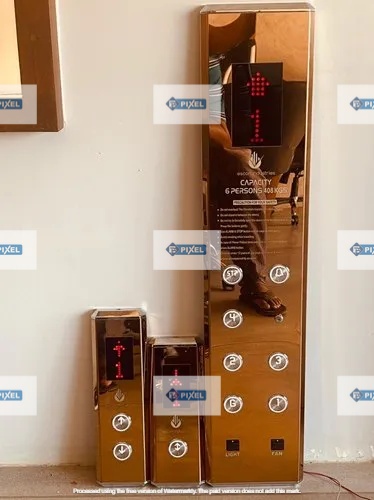#Elevator-LOP-manufacturers #Elevator-Control-panel-manufacturers #Pixel-Control "Elevator LOP" likely stands for "Elevator Level of Protection" in the context of building or elevator safety. It refers to the safety measures, features, and standards implemented in elevators to protect passengers and ensure safe operation. Elevator LOP typically includes a combination of mechanical, electrical, and software-based safety features that are designed to prevent accidents, injuries, or malfunctions in elevators. Some common examples of Elevator LOP features include: Door sensors: These sensors detect the presence of objects, such as passengers or obstacles, in the path of the elevator doors. They prevent the doors from closing if an object is detected, thereby avoiding accidents. Overload protection: This feature ensures that the elevator does not exceed its maximum weight capacity. If the elevator is overloaded, it may trigger an alarm, stop the elevator, or prevent it from moving, thus preventing potential accidents. Emergency stop button: Passengers can use the emergency stop button to halt the elevator in case of an emergency, such as a medical emergency or a safety concern. This allows passengers to quickly stop the elevator and seek help if needed. Safety brakes: Elevators are equipped with safety brakes that engage in case of a mechanical failure or power outage. These brakes prevent the elevator from falling or moving uncontrollably and help ensure passenger safety. Fire-rated doors: Elevator doors are often designed to be fire-rated, which means they can resist fire and prevent the spread of smoke or flames between floors during a fire emergency, providing additional safety for passengers. Backup power supply: Elevators typically have a backup power supply, such as a battery or a generator, to ensure that the elevator can operate safely during a power outage and passengers can be safely evacuated. Compliance with building codes and regulations: Elevator LOP also includes adherence to local building codes and regulations, which specify safety standards and requirements for elevator installation, maintenance, and operation. Overall, Elevator LOP is a comprehensive approach to elevator safety that incorporates multiple safety features and standards to ensure the safe and reliable operation of elevators in buildings.
Chat with us on WhatsApp
×
This is your website preview.
Currently it only shows your basic business info. Start adding relevant business details such as description, images and products or services to gain your customers attention by using Boost 360 android app / iOS App / web portal.

2023-04-14T13:04:22
#Elevator-LOP-manufacturers #Elevator-Control-panel-manufacturers #Pixel-Control "Elevator LOP" likely stands for "Elevator Level of Protection" in the context of building or elevator safety. It refers to the safety measures, features, and standards implemented in elevators to protect passengers and ensure safe operation. Elevator LOP typically includes a combination of mechanical, electrical, and software-based safety features that are designed to prevent accidents, injuries, or malfunctions in elevators. Some common examples of Elevator LOP features include: Door sensors: These sensors detect the presence of objects, such as passengers or obstacles, in the path of the elevator doors. They prevent the doors from closing if an object is detected, thereby avoiding accidents. Overload protection: This feature ensures that the elevator does not exceed its maximum weight capacity. If the elevator is overloaded, it may trigger an alarm, stop the elevator, or prevent it from moving, thus preventing potential accidents. Emergency stop button: Passengers can use the emergency stop button to halt the elevator in case of an emergency, such as a medical emergency or a safety concern. This allows passengers to quickly stop the elevator and seek help if needed. Safety brakes: Elevators are equipped with safety brakes that engage in case of a mechanical failure or power outage. These brakes prevent the elevator from falling or moving uncontrollably and help ensure passenger safety. Fire-rated doors: Elevator doors are often designed to be fire-rated, which means they can resist fire and prevent the spread of smoke or flames between floors during a fire emergency, providing additional safety for passengers. Backup power supply: Elevators typically have a backup power supply, such as a battery or a generator, to ensure that the elevator can operate safely during a power outage and passengers can be safely evacuated. Compliance with building codes and regulations: Elevator LOP also includes adherence to local building codes and regulations, which specify safety standards and requirements for elevator installation, maintenance, and operation. Overall, Elevator LOP is a comprehensive approach to elevator safety that incorporates multiple safety features and standards to ensure the safe and reliable operation of elevators in buildings.
2023-04-14T13:04:22
Keywords
- help
- path
- case
- alarm
- smoke
- spread
- flames
- floors
- objects
- context
- battery
- injuries
- presence
- generator
- buildings
- obstacles
- elevators
- adherence
- Compliance
- passengers
- maintenance
- regulations
- combination
- requirements
- malfunctions
- power outage
- Door sensors
- Safety brakes
- Pixel-Control
- safe operation
- elevator doors
- Elevator Level
- fire emergency
- safety concern
- elevator safety
- safety measures
- common examples
- safety standards
- Fire-rated doors
- passenger safety
- additional safety
- medical emergency
- reliable operation
- mechanical failure
- Backup power supply
- potential accidents
- Overload protection
- local building codes
- elevator installation
- Elevator LOP features
- Emergency stop button
- comprehensive approach
- maximum weight capacity
- multiple safety features
- Elevator-LOP-manufacturers
- software-based safety features
- Elevator-Control-panel-manufacturers

Submit Your Enquiry